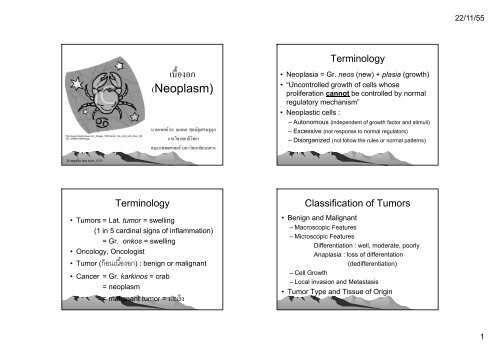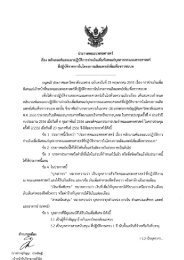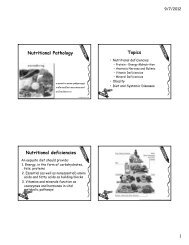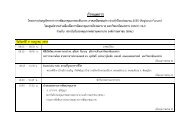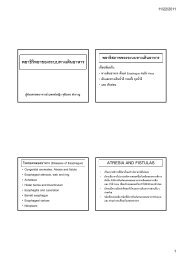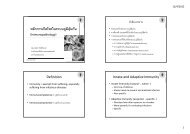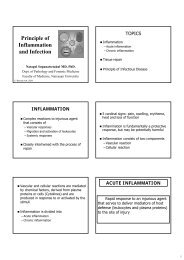เนืองอก (Neoplasm)
เนืองอก (Neoplasm)
เนืองอก (Neoplasm)
Create successful ePaper yourself
Turn your PDF publications into a flip-book with our unique Google optimized e-Paper software.
22/11/55http://www.clipartreview.com/_images_300/Cancer_the_crab_with_stars_100421-235886-448009.jpg30 พฤศจิกายน พ.ศ. 2555<strong>เนืองอก</strong>(<strong>Neoplasm</strong>)นายแพทย์ ดร. ณตพล ศุภณัฐเศรษฐกุลภาควิชาพยาธิวิทยาคณะแพทยศาสตร์ มหาวิทยาลัยนเรศวรTerminology• Neoplasia = Gr. neos (new) + plasia (growth)• “Uncontrolled growth of cells whoseproliferation cannot be controlled by normalregulatory mechanism”• Neoplastic cells :– Autonomous (independent of growth factor and stimuli)– Excessive (not response to normal regulators)– Disorganized (not follow the rules or normal patterns)Terminology• Tumors = Lat. tumor = swelling(1 in 5 cardinal signs of inflammation)= Gr. onkos = swelling• Oncology, Oncologist• Tumor (ก้อนเนื องอก) : benign or malignant• Cancer = Gr. karkinos = crab= neoplasm= malignant tumor = มะเร็งClassification of Tumors• Benign and Malignant– Macroscopic Features– Microscopic FeaturesDifferentiation : well, moderate, poorlyAnaplasia : loss of differentation(dedifferentiation)– Cell Growth– Local invasion and Metastasis• Tumor Type and Tissue of Origin1
22/11/55• Benign tumor :Macroscopic Features– Sharply demarcated– Encapsulated– Homogenous– Easy to remove• Malignant tumor :– Lack a capsule– Invade the surrounding tissue– Heterogeneous with hemorrhage and necrosis– Difficult to totally removeMicroscopic FeaturesWellDifferentiated• Benign tumor :– Well differentiated (resemble tissue of origin)– No anaplasia• Malignant tumor :– Poorly differentiated or undifferentiated– Prominent anaplasia (different from normaltissue considerably)http://www.grin.com/object/external_document.237742/03859758dd392bf614e1ff70bcd4a902_LARGE.pngPoorlyDifferentiated(Anaplasia)2
22/11/55• Benign tumor :Cell Growth– Uniform cell population with regular shape nuclei– Slower growth rate• Malignant tumor :– Heterogeneous cell population– Nuclear pleomorphism (variable in size, shape,and staining properties)– High N/C ratio with prominent nuclei– Faster growth ratehttp://upload.wikimedia.org/wikipedia/commons/5/5b/Uterine_leiomyoma_(2).jpgLeiomyomaLocal Invasion and Metastasis• Benign tumor :– Expansive growth and compress adjacentnormal tissue– Remain localized• Malignant tumor :– Invasion to the surrounding tissue– Capable of distant metastasisLeiomyosarcomahttp://www.uaz.edu.mx/histo/pathology/ed/ch_18/c18_leiomyosarc.jpg3
22/11/55Benign & Malignant TumorsCharacteristics Benign MalignantHistology(differentiation,anaplasia)- Typical oftissue of origin- Well diff. withno anaplasia- Poorly diff.- Anaplastic,abnormal cellsize and shapeGrowth rate Slow RapidLocalization Local, capsule InfiltrativeinvasionMetastasis No YesRecurrence Rare CommonPrognosis Good PoorTumor type and Tissue of Origin• Epithelial tumors• Mesenchymal tumors• Tumors of blood cells and lymphocytes• Tumors of neural cell precursors and neuralsupporting cells• Germ cells tumorsEpithelial tumors• Benign : suffix – oma• Malignant : suffix – carcinoma• Squamous cell epithelium– Papilloma – Squamous cell carcinoma• Glandular/ductal epithelium– Adenoma - Adenocarcinoma• Transitional epithelium– Transitional cell adenoma – Transitional cell CA4
22/11/55Mesenchymal tumors• Benign : suffix – oma• Malignant : suffix – sarcoma• Fibroblast : Fibroma - Fibrosarcoma• Fat cell : Lipoma - Liposarcoma• Smooth muscle: Leiomyoma - Leiomyosarcoma• Striated muscle: Rhabdomyoma – ~-sarcoma• Cartilage : Chondroma - Chondrosarcoma• Bone : Osteoma - OsteosarcomaTumors of Blood cells andLymphocytes• All malignant tumors• White blood stem cells – Leukemia• Lymphoid cells – Lymphoma• Plasma cells – Multiple myelomaTumors of neural cell precursorsand neural supporting cells• Neuroblast : Neuroblastoma (malignant)• Glial cells : Glioma (malignant)• Meningeal cells : Meningioma (benign)• Schwann cells : Schwannoma (benign)Germ cell tumors• Embryonic cells• Benign tumor : Teratoma (dermoid cyst)• Malignant tumors : TeratocarcinomaSeminoma5
22/11/55Characteristics of CancersTeratoma (dermoid cyst): hair, teeth, cartilage, sebaceous• Autonomous and Immortal– Growth-promoting– Growth-inhibiting (apoptosis)• Angiogenesis, central hemorrhage & necrosis• Loss of differentiation and increase abnormalfeatures (anaplasia)• Local invasion• Distant metastasishttp://www.med.cmu.ac.th/student/patho/Surapan/106.jpgCauses of Cancer• Exogenous causes– Cancerogenic factors(carcinogen, cancer-forming factors)– Chemicals– Physical agents– Viruses• Endogenous causes– Genetic trait, heritabilityChemical Carcinogens• Polycyclic aromatic hydrocarbons– 3,4-Benzpyrene – tobacco – CA lung– Aflatoxin B1 – Aspergillus flavus – liver cancer• Aromatic amines– Naphthylamine – azo dyes – bladder cancer• Nitrosamines– Nitrites and nitrates – meat product – CA colon• Steroid hormones– Estrogen – supplement – endometrial cancer6
22/11/55Physical carcinogens• Radiation• Ultraviolet light (UV)• X-rays• Radioactive isotopes• Atomic bombs• Skin cancer (SCC, BCC, melanoma),leukemia, thyroid cancerViral Carcinogens• Human papilloma virus (HPV)– Common warts, genital warts– HPV type 16, 18 – Cancer of cervix• Epstein-Barr virus (EBV)– Burkitt’s lymphoma (B-cell neoplasia)– Nasopharyngeal carcinoma• Hepatitis B virus (HBV)– Hepatocellular carcinoma• Human T-cell lymphoma/leukemia virus 1(HTLV-1)Genetic Mechanisms of CA• Altered expression of cellular genes“somatic genetic disorders”– Nonlethal genetic damage (mutations)• Proto-oncogenes• Tumor suppressor genes– Clonal expansion– DNA repair defect– Acquire new mutations malignant propertiesProto-oncogenes• Proto-oncogenes mutation oncogenes oncoproteins promote autonomouscell growth cancer• Ex. Growth factors (PDGF), Growth factorreceptors (EGFR), cytoplasmic signalmolecules (K-RAS), nuclear transcriptionfactors (c-myc)7
22/11/55Tumor Supressor Genes• Growth inhibitory signals– Rb gene: retinoblastoma, osteosarcoma– P53: most human cancers (brest and colon CA)– BRCA-1/BRCA-2: breast & ovarian cancers• 3% all breast cancer• 80% familial breast cancer• Evasion of apoptosis– Bcl-2Grading and Staging• Grading: histologic characterization oftumor cells and is basically adetermination of the degree of anaplasia(grade 1, 2, 3, 4)• Staging: location and pattern of spread ofa tumor within the host– International Contre Center TNM (tumor,Node, Metastasis)– American Joint Committee Stage 0 - IVWellDifferentiatedhttp://www.grin.com/object/external_document.237742/03859758dd392bf614e1ff70bcd4a902_LARGE.pngPoorlyDifferentiated(Anaplasia)http://edoc.hu-berlin.de/dissertationen/kaiser-simone-2004-06-10/HTML/kaiser2_html_7fe064af.png8
22/11/55Invasion and Metastasis• Invasion of extracellular matrix• Invasion into vascular• Vascular dissemination– Lymphatic lymph nodes– Blood vessels distant organs• Tumor implantation– Favoring new location homingMetastasisEffects of cancer on body• Location & impingement on adjacentstructures• Functional activity such as hormone• Bleeding & secondary infections• Initiation of acute symptoms (rupture,infarction)9
22/11/55Effect of cancer on body• Cachexia: overall weight loss and generalizedweakness due to– Anorexia (loss of appetite)– High metabolism by cancer cells– Therapeutic effect nausea, vomiting• Pain: patient-controlled analgesia• Fear, depression• Paraneoplastic syndromes: venous thrombosis,cushing syndrome, hypercalcemiaFigure 5-13 Cancer incidence and mortality by site and sex.(Adapted from Jemal A, Siegel R, Xu J, Ward E: Cancer statistics, 2010.CA Cancer J Clin 60:277-300, 2010.)In Thailand 2010• ข้อมูลจากสถาบันมะเร็งแห่งชาติ ปี 2010(http://www.nci.go.th/File_download/Nci%20Cancer%20Registry/hospital-based%202010.pdf)• มะเร็งทีพบมากทีสุดในผู ้ชาย ได้แก่Trachea, bronchus and lung (23.6%),Colon and rectum (21.5%), Liver and bile duct (17.3%)• มะเร็งทีพบมากทีสุดในผู ้หญิง ได้แก่Breast (47.8%), Cervix uteri (16.2%), Colon & rectum (10.4%)การค้นหาและป้ องกันมะเร็ง• สถาบันมะเร็งแห่งชาติ (http://www.nci.go.th/index.html)• การตรวจหามะเร็งระยะเริมแรกhttp://www.nci.go.th/Knowledge/firststep.html• ข้อพึงปฏิบัติในการป้องกันการเกิดโรคมะเร็งhttp://www.nci.go.th/Knowledge/do12.html• ความรู้ทัวไปเกียวกับโรคมะเร็งhttp://www.nci.go.th/Knowledge/filedownload.html#0710
22/11/55References• Damjanov I., “Pathology for the HealthProfessions, 4 th edition.”, Elsevier Saunders, 2012,p. 67-90.• Kumar V., Abbas A.K., Aster J.C., “Robbins BasicPathology, 9 th edition.” Elsevier Saunders, 2013,p.161-214.• Kumar V., Abbas A. K., Fausto N., “Robbins andCotran Pathologic Basis of Disease, 7 th edition.”,Elsevier Saunders, 2005, p. 3-46.11


